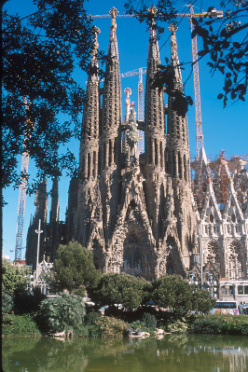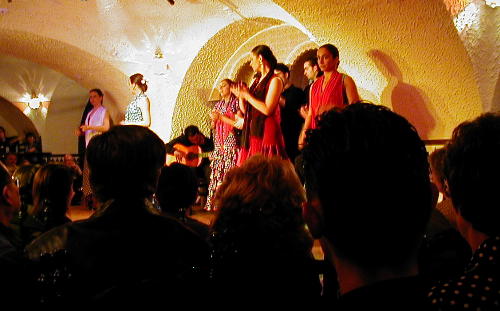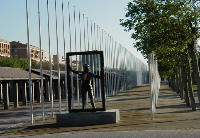BARCELONA
by
Louis Bignami
Barcelona deserves an extra day or two before for those who drive in, take the convenient train from the French Riviera or, as is increasing the case, opt for Med Cruise. Those who start or end cruises here find no other town so convenient to the ship – it’s an easy 15-minutes walk to the old Los Robles section of shops and superior architecture. And there’s a good assortment of hostel to five star accommodation, and no other town has such wonderful waterfront complex of restaurants, cafes and shops.
If you’ve not visited since the Olympics, you’ll discover a clean well-policed town with miles of walkways along what used to be a rather tacky waterfront area.
Olympic Center
photo credit: Annette Bignami
Best of all, Barcelona is a closed city that’s replaced suburban sprawl with downtown rehab. Catalans, the best businessmen in Europe, simply do it better.
So skip the highlights tour that, aside from a too quick sit down lecture in the wonderful 600-year old Catalan Santa Eulalia during which wise visitors explore on their own to sample all the wonderful alcoves and gilded crannies. Tours are mostly a drive or walk by. So you miss oddments like the stone goose igloo in the central court at the Cathedral and only see the outside of Gaudi’s buildings.
So go it on your own. Hike down to the Statue of Columbus, turn right and check out the Gaudi buildings, splendid shops and interesting architecture on the way to the sand candle architecture of Gaudi’s Church of the Sagrada Familia well-worth the wait for tickets to the interior. Started in 1884 it “may be finished by 2084.” So it serves as both a reminder of the effort that went into Medieval and Gothic cathedrals, and the unique art of architecture of Catalonia. It’s worth noting that “gaudy” didn’t come from Gaudi, but it should have!

Gaudi's Church of The Sagrada Familia
photo credit: Louis Bignami
See the Church of the Sagrada Familia and you better understand Picasso, Miro and Dali – the first two have exceptional museums conveniently downtown that, with the scores of bars and cafes offering plates of assorted hot and cold bite-size tapas and pans of seafood paella mean there’s no need to head back to the ship for lunch.
The other Gaudi buildings of note conveniently cluster downtown among some very nice, and conservative upscale clothing outlets – Locals dress rather formally and well. Other good values include jewelry, pearls, lace and wood-carvings. Nobody is pushy in shops so you can slide in take a look and leave with nothing more than a “gracias.”
Outside the old quarter Montjuic, the “Jewish Mountain” with it’s splendid views is a good spot to start a visit and the cable gondola near the dock takes you up the Mont as some risk of pickpockets. The fine arts museum is here and a section of conveniently clustered Spanish building replicas offer solid shopping. The Mont is worth a visit and you can ride up in the cable gondola near the cruise line docks and walk back downhill.
With more time to spend. Day trips to Montserrat Monastery with art by Manet, Monet and Picasso and, with good timing the La Salve Choir. Stiges beach life also deserves a look,-- among other things a great many beaches are topless, and France is but an hour’s train ride north along the coast.
Andorra,
while lately infested with hordes in search of duty free bargains, is but a half-day
bus trip. There’s decent winter
skiing – better skiing in the Pyrenees and oddments like trout fishing few
visitors sample. 
Flamenco Dancers
photo credit: Annette Bignami
Nightlife starts very late Skip the evening flamenco tour at $70 with two drinks and bus transport advertised, and on the last try one drink, and seats to the side delivered creating bad feelings before it was discovered you could book a show on your own for $25 plus a $4 cab ride. The flamenco was, if modestly aimed at tourists and limited to a single male dancer, reasonable value at the lower rate.
There are better flamenco cafes in town and you can ask about these at local guitar shops.
Fortunately, tapas, the wonder Spanish version of the finger food so typical of the Med, fill the gap between the time Americans like to eat and the 10 o’clock dining time for locals. Grazing tapas from bar to bar makes excellent sense and delivers more kids of food for the dollar than you’ll find in Barcelona’s sophisticated restaurants. Locals seem to start with the strong local coffee or cocoa and graze all day, so there’s no “come back later nonsense.
Drawbacks? Barcelona can be an expensive city if you go the five star route, but the thousands of students insure solid lodging, affordable food and a dandy evening atmosphere as everyone gets out on the streets to enjoy the usually reliable weather. It’s a vastly underrated town and my favorite Spanish city even though I have trouble understanding the Catalan most locals speak. Fortunately, everyone also speaks Spanish, and most speak French as Catalan sort of falls between these languages.

